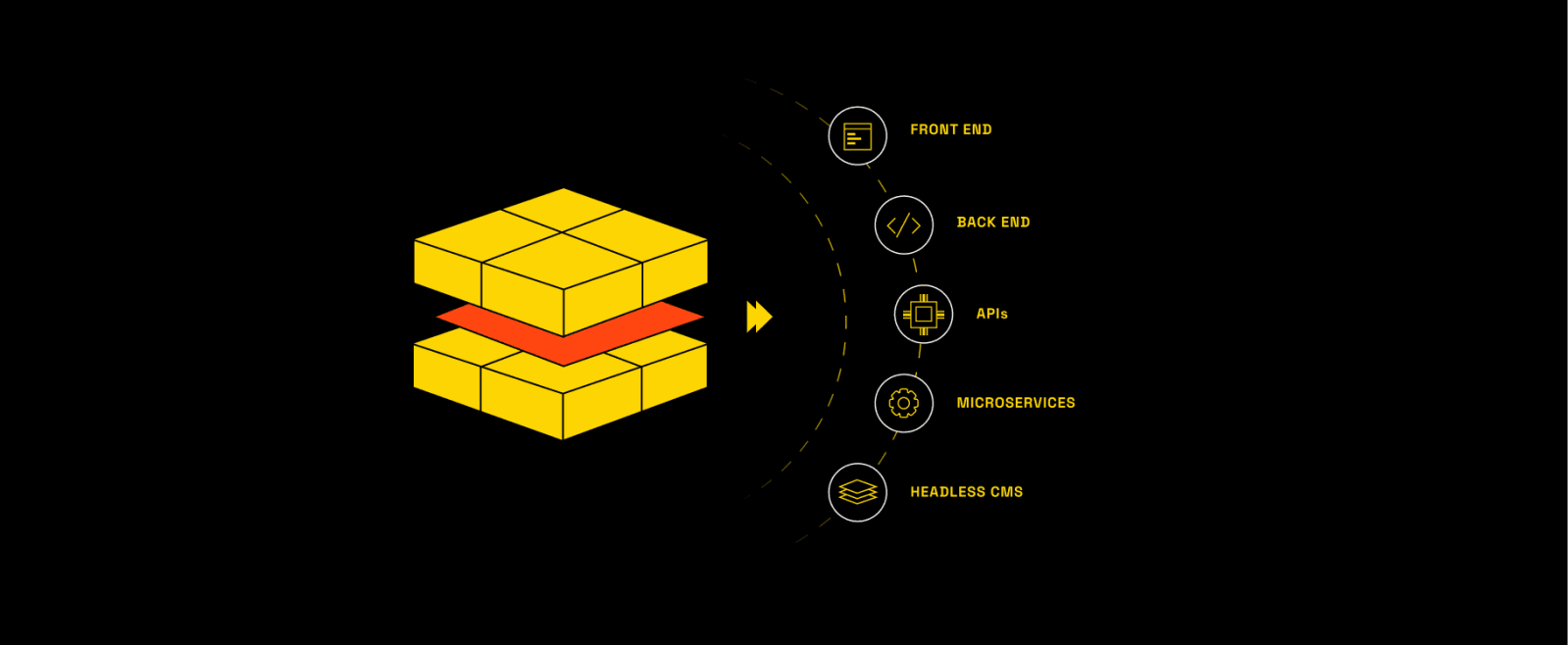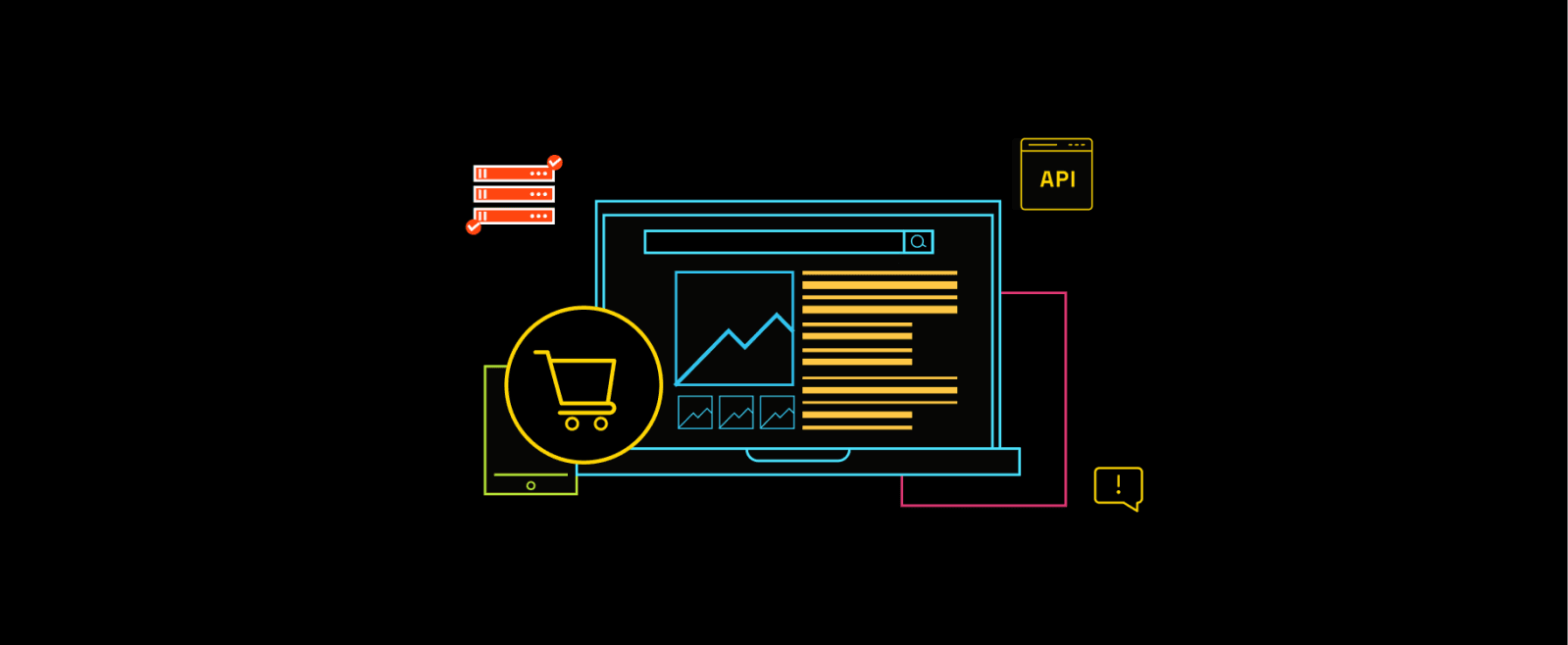The Real Difference Between Composable vs MACH vs Headless Commerce Architectures
Choosing the right commerce architecture — Composable, MACH, or Headless — can shape your brand’s ability to scale, adapt, and compete. But with so much overlap between these terms, it’s easy to misread what each one actually enables.
This comparison guide breaks down the real differences between Composable vs MACH vs Headless architecture — so you can align your decision with your team structure, business model (B2B, B2C, or D2C), and long-term growth strategy.
Whether you're replatforming from a monolith or scaling a modular tech stack, the goal is the same: build infrastructure that flexes with the business, not against it.
Composable, MACH, Headless: What's the Real Difference?
In enterprise commerce conversations, “Composable,” “MACH,” and “Headless” are often used interchangeably—but the differences are critical. Each represents a different layer of your architecture:
-
Headless gives you frontend flexibility.
-
MACH defines how your backend systems are built and connected.
-
Composable focuses on assembling business capabilities through modular services.
Understanding the difference between MACH and Composable, or between Headless and MACH, is no longer optional—it directly affects your stack’s scalability, vendor fit, and team readiness.
Because all three approaches promise modularity and speed, their boundaries blur easily. But treating them as interchangeable often leads to mismatched architectures—like deploying MACH infrastructure when your business needed orchestration flexibility, or adopting headless when modular APIs aren’t enough.
Think of it like this:
-
Headless handles what the customer sees.
-
MACH governs how services interact.
-
Composable maps tech decisions directly to business goals.
Current State of Digital Commerce Architecture
As more platforms rebrand themselves as “modular,” architecture decisions are getting harder—not easier. Legacy monoliths now claim to be headless. API-based systems are mistaken for composable. For enterprise leaders, this makes it crucial to look past labels and evaluate what actually fits your business model and team setup.
Choosing the right model—whether it’s MACH, Headless, or Composable—impacts how you scale your tech team, budget for integrations, work with vendors, and plan product releases. This guide will help you map each model to your current needs and future growth.
The real difference between these models isn’t technical, it’s strategic. It comes down to:
-
Who controls your roadmap?
-
How fast can you adapt without rebuilding?
-
And what trade-offs are you willing to make for speed, scale, or flexibility?
Headless Architecture: The Foundation of Modern Commerce
Headless architecture was the first major step away from monolithic commerce. It decouples the customer-facing frontend from the backend logic—giving brands freedom to build fast, custom experiences across channels without overhauling their entire system.
Most teams start here: they want faster UI updates, omnichannel consistency, and more control over the storefront. But that’s where headless ends—and where MACH and Composable begin.
Contrasting Headless with MACH and Composable
Here's how the three compare at a high level:
| Architecture | What it Enables | What's Missing |
|---|---|---|
| Headless | Decoupled frontend and backend for fast UI delivery | No modular services, limited backend agility |
| MACH | Modular services, API connectivity, cloud scalability | Still needs business logic orchestration |
| Composable | Full business capability orchestration, plug-and-play architecture | Requires highest strategic and technical maturity |
While headless gives you flexibility at the presentation layer, MACH extends flexibility to infrastructure. Composable builds on both—aligning architecture to business capabilities and outcomes.
When Headless Works—and When It Doesn't
Headless architecture brings flexibility—but it also adds architectural complexity. You’ll need internal teams capable of managing APIs, owning frontend deployments, and integrating services manually. For smaller orgs or teams without strong tech depth, headless can create more work than it solves.
If your challenges are deeper than frontend delivery—like managing promotions, workflows, personalization, or backend operations—headless will only get you partway there.
MACH Architecture: A Framework for Scalable Modularity
MACH architecture is built for engineering-led scale. It takes headless further by turning backend services into fully modular, API-driven components—each one independently deployable and cloud-native by design. The goal: speed up delivery, reduce infrastructure risk, and unlock technical velocity.
The MACH model follows four technical principles—Microservices, API-first, Cloud-native, and Headless—all working together to break monoliths into scalable, composable pieces. But MACH’s power lies in how those pieces are governed, not just how they’re built.
What MACH really changes is how teams ship. Updates can be made to one service without touching the rest. Teams can work in parallel. Deployments become faster, safer, and more independent. For CTOs, MACH isn't just modular—it’s a way to reduce bottlenecks and make delivery more predictable.
MACH is infrastructure-first—it gives your teams the technical modularity to move faster. But MACH alone doesn’t solve business orchestration or vendor sprawl. That’s where Composable enters: not as a replacement, but as the next layer of strategic control.
Composable Commerce: Strategy-First, Tech-Flexible
If MACH redefined how you build commerce platforms, Composable redefines why. Instead of starting with infrastructure, Composable commerce begins with business needs—then maps the right technology around them.
It’s not just a tech architecture. It’s a framework for creating agile, modular ecosystems that let you respond to change without rewriting your entire stack.
Why Composable Isn’t Just MACH with a Marketing Layer?
While MACH provides the technical foundation (microservices, APIs, cloud-native scale), it doesn't tell you how to assemble those components based on business priorities. That’s where Composable comes in—with a focus on Packaged Business Capabilities (PBCs).
PBCs are modular services designed around business functions (e.g., product discovery, checkout, pricing). They’re often built as collections of microservices, but governed as standalone, swappable capabilities—allowing organizations to adapt at the capability level, not just the technical layer.
Making Composable Work: What It Actually Involves
Composable commerce isn't plug-and-play. It requires architectural intention and strong internal maturity across:
- PBC Orchestration:
Aligning capabilities like search, catalog, promotions, and pricing into a cohesive user journey.
- Vendor Strategy:
Selecting best-of-breed solutions that integrate cleanly and support your specific use cases—without locking you into rigid workflows.
- Internal Capability Building:
Training or hiring teams who can work across orchestration layers, manage modular services, and adapt systems over time.
- Governance and Change Management:
Defining ownership across services, managing updates across vendors, and ensuring performance at scale.
Done right, this approach allows brands to evolve every part of the experience—without tearing down what works.
Where Composable Shines: Business-Centric Use Cases
Composable isn't a one-size-fits-all solution. It’s most powerful in organizations with complex, evolving business needs:
- B2B Industrial:
A global electrical equipment supplier uses Composable architecture to manage multi-tier pricing, distributor-specific catalogs, and real-time product availability via ERP sync—across 12 regions and 4 fulfillment models.
- Cross-Border Fashion Brand:
A fast-growing D2C apparel label selling in 8 countries orchestrates local payment systems, region-specific promotions, and seasonal drops using modular promotion, cart, and loyalty services.
- Global Grocery + Delivery Network:
A grocery chain with both eCommerce and in-store delivery integrates PBCs for inventory, pickup scheduling, delivery ETA, and order modification—all independently deployable and vendor-managed.
Each of these examples shows what MACH alone can’t solve: business capability orchestration across vendors, markets, and moments.
Why Composable Future-Proofs Your Stack
Composable commerce doesn’t lock you into one vendor, one architecture, or one way of scaling. It lets you adapt your commerce strategy as customer expectations shift—whether that means rolling out new channels, adding AI-powered personalization, or replacing a legacy checkout flow with something better.
Composable vs MACH vs Headless: Which One Fits Your Business?
Here’s how Composable, MACH, and Headless architectures stack up across critical decision-making factors, so you can choose based on what your business actually needs.
| Criteria | Composable | MACH | Headless |
|---|---|---|---|
| Primary Use Case | Modular business orchestration | Scalable technical architecture | Frontend flexibility |
| Best For | Complex B2B/B2C, multi-capability orgs | Fast-scaling B2C, multi-region ops | D2C or early-stage digital teams |
| Integration Load | High – multiple vendors, layered logic | Medium – service-level integrations | Low – single backend, decoupled frontend |
| Team Requirements | Requires cross-functional ownership (business + tech) | Engineering-heavy teams with DevOps maturity | Frontend devs with API literacy |
| Governance Complexity | High – needs orchestration and vendor management | Medium – governed via infra standards | Low – mostly UI and API-focused |
| Speed to Value | Slower to start, faster to adapt later | Medium setup, scales well | Fast initial launch, limited depth |
| How It Scales | Capability-by-capability, vendor-agnostic | Service-by-service, tech-driven | Experience-layer only – no backend modularity |
Composable vs MACH vs Headless: Best Fit by Business Type
Different business models demand different levels of flexibility, control, and scale. Here’s how to think about the right fit:
-
B2B businesses with complex product catalogs, workflows, and buyer roles tend to benefit most from Composable Commerce. It allows you to integrate custom pricing engines, layered approvals, and ERP sync without rebuilding your entire stack.
-
B2C retailers scaling across multiple geographies often choose MACH architecture. Its modular backend, cloud scalability, and API-first services make it easier to support regional sites, promotions, and loyalty systems at scale.
-
D2C brands—especially those in early stages or without deep engineering teams—often go Headless first. It gives them more design freedom and channel control, without overwhelming technical overhead.
How MACH, Headless, and Composable Work Together
These three models aren’t mutually exclusive—they layer on top of one another.
Think of your architecture stack like this:
-
Headless is the presentation layer. It decouples the UI from the backend so you can ship faster and deliver across channels.
-
MACH is the infrastructure layer. It gives you modularity, scalability, and service-based development—but doesn’t dictate how your services should be structured from a business POV.
-
Composable is the orchestration layer. It turns MACH into a business-aligned system, built around capabilities like search, pricing, loyalty, and fulfillment.
Composable is not MACH with better branding. It’s MACH with business orchestration baked in.
Still unsure which model fits your business? Use this litmus test:
-
If your problems are mostly UI/UX related, headless might be enough—for now.
-
If you need modular tech at scale, MACH is likely the right step.
-
If your org structure, product catalog, or customer journeys are inherently complex—Composable is the only architecture that will grow with you.
How to Prepare for MACH, Composable, or Headless Implementation
Selecting the right architecture requires careful consideration of your organization's unique context and capabilities. Let's examine the critical factors that should guide your decision-making process.
How to Assess Technical Readiness
Before committing to any architecture:
-
Can your team own API integrations and manage versioned services?
-
Are you structured for cross-functional ownership (not just IT)?
-
Have you mapped out your DevOps, observability, and rollback needs?
Implementation Strategy: Crawl, Walk, Run
Your path to implementation should be methodical and staged:
-
Audit your existing stack — Identify what’s staying, what’s being modularized.
-
Start with Headless (if needed) — It’s often the lowest-risk entry point.
-
Decouple one capability at a time — e.g., catalog, search, pricing.
-
Build orchestration last — Don’t jump to Composable until you have control over foundational services.
Operational Pitfalls to Avoid
Even with the right architecture choice, execution can derail fast if your organization isn’t set up to support it. These are the most common pitfalls we’ve seen when teams move to Composable, MACH, or Headless architectures:
- Don’t assume MACH = automatic agility
Modular tech doesn’t create agility by default. Without strong governance, it can create more silos—not fewer.
- Don’t underestimate change management
These architectures reshape how teams collaborate. If business and engineering aren't aligned early, rollout stalls or breaks.
- Don’t skip ownership clarity
Who owns pricing? Who owns search? Without capability-level ownership, you’ll struggle to evolve services or troubleshoot fast.
- Assign product owners to capabilities
Each business capability—like checkout, loyalty, or catalog—needs a clear owner with both strategic and technical oversight.
- Invest in developer education
API-first and microservices require new mental models. Your teams need time and training to build, orchestrate, and maintain modular systems.
- Treat documentation like a product
Your architecture is only as resilient as your internal knowledge. Prioritize onboarding assets, service guides, and integration playbooks.
A well-chosen architecture will fail without the operational maturity to support it. Invest there just as seriously as you invest in tech.
Organizational Red Flags (Readiness Checklist)
Technical
-
Can you manage event-based systems and service uptime independently?
-
Is your API infrastructure production-ready?
Organizational
-
Do you have product owners per business capability?
-
Are your devs and ops teams aligned on modular workflows?
Resource
-
Can you afford a 2–3x longer discovery phase?
-
Are you prepared for short-term cost spikes before long-term ROI?
The success of any architecture—Composable, MACH, or Headless—has less to do with the tools you choose, and more to do with your readiness to operate and scale them.
Start small. Sequence capabilities. And build a system that matches your internal rhythm—not just market trends.
What Comes Next: Future-Proofing Your Commerce Stack
As commerce technology rapidly evolves, staying ahead requires more than just adopting current best practices. Emerging innovations are reshaping how businesses design and operate their digital commerce platforms. Here's what to anticipate:
1. Agentic AI: Autonomous Decision-Making in Commerce
Agentic AI systems are transforming e-commerce by enabling autonomous decision-making, dynamic personalization, and AI-powered supply chain management. These systems analyze vast data streams in real time, providing actionable insights and executing tasks without human intervention. For instance, Amazon has developed AI agents capable of recommending products, adding items to carts, and even making purchases on behalf of customers, aiming to enhance the shopping experience and operational efficiency.
Gartner predicts that by 2029, Agentic AI will autonomously resolve 80% of common customer service issues without human intervention, potentially reducing operational costs by 30%.
2. Vertical SaaS: Industry-Specific Solutions
Vertical SaaS platforms are gaining traction by offering tailored solutions for specific industries such as healthcare, retail, and manufacturing. These platforms solve niche problems—like regulatory compliance, localized workflows, and B2B-specific pricing models—that horizontal solutions often can’t.
According to the 2024 Vertical & SMB SaaS Benchmark Report by High Alpha, vertical SaaS companies are growing at a median rate of 45%, significantly outpacing horizontal SaaS at 28%. That performance gap reflects how well these platforms resonate with industry-specific needs—delivering higher stickiness, faster adoption, and better long-term ROI.
For enterprise commerce teams, this trend reinforces the need for an architecture that’s flexible enough to integrate specialized, best-fit tools as they emerge.
3. Automation-First Workflows: Streamlining Operations
Adopting an automation-first mindset is becoming essential for modern commerce operations. By prioritizing automation across business functions, companies can reduce manual errors, enhance efficiency, and allocate resources to strategic initiatives. This approach involves leveraging AI-driven workflows to handle repetitive tasks, allowing teams to focus on higher-value activities.
By aligning your architecture with these emerging trends, you position your business to thrive in an increasingly dynamic digital landscape.
Conclusion
The stack you build today defines how fast you move, how well you scale, and how much control you retain tomorrow. So, choosing between composable, MACH, and headless isn't just a technical decision—it's an operating model choice.
If you're re-evaluating your architecture or need help aligning your tech with your business model, we’ve helped enterprise teams navigate exactly that.
👉 Drop us a line at hello@coderapper.com to talk through where you are, where you're headed, and how to get there without ripping everything up.






